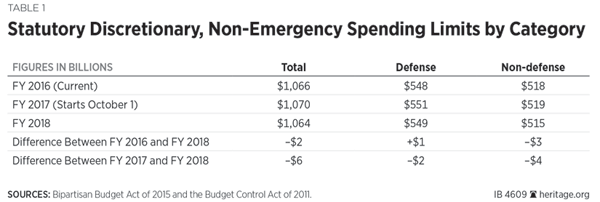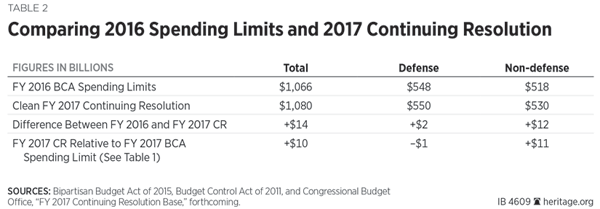The budget process, specified in the Congressional Budget Act of 1974, calls for Congress and the President to reach agreement on 12 separate annual appropriations bills before the fiscal year (FY) ends on September 30. In recent years, Congress and the President have failed to enact these bills as standalone measures, leaving the federal government to operate on a series of temporary continuing resolutions, omnibus spending bills, and a 16-day government shutdown in the fall of 2013.
Members of the House and Senate have promised time and again throughout the year to return to “regular order” by passing all of the spending bills before September 30. The process once again derailed over the summer and only the Military Construction and Veterans Affairs appropriations bill has been passed by both chambers and gone through the conference committee process. However, the conference agreement has failed to pass the Senate.[1]
One of the factors leading to the breakdown of regular order in 2016 was the passage of the Bipartisan Budget Act of 2015, better known as the Obama–Boehner spending deal. This legislation raised the Budget Control Act (BCA) statutory discretionary spending caps by $50 billion in FY 2016 and $30 billion in FY 2017.[2] The bill was supported by only 79 out of 246 House Republicans voting, and the continuing unpopularity of the increased spending cap made it impossible for the House to reach agreement on an FY 2017 budget resolution this spring.[3]
Congress should finish its work by passing all annual appropriations measures before adjourning for the November 2016 presidential and congressional elections. Furthermore, Congress should fund the government at a level below the Obama–Boehner spending agreement to avoid setting themselves up to break the Budget Control Act’s spending caps in either the 2016 lame duck or in 2017.
If Congress passes an unamended or clean continuing resolution for any length of time or an omnibus spending bill at the Obama-Boehner level of $1.070 trillion for fiscal year 2017, they will set themselves up to break the BCA spending limits for FY 2018, which is currently set by law at $1.064 trillion ($549 billion for defense, not including war spending, and $515 for non-defense spending).
Congress Is Setting Itself Up for Failure
Since their enactment in 2011, the discretionary limits put in place by the BCA have been raised five times. By reverting back to the BCA level or lower in 2017, Congress can reaffirm its commitment to correcting the unsustainable fiscal course the nation is currently on and take concrete steps to start fixing the problem. With the 2018 BCA cap currently set at $1.064 trillion, if action is not taken this year to reduce spending below that level, Congress is setting itself up for another Obama–Boehner-type deal going into FY 2018. The BCA caps were put in place as a mechanism to make real spending reductions and control ever growing deficit and debt levels. The country cannot afford for Congress to circumvent the caps again.
Funding the government through continuing resolutions is far from ideal policy. In an ideal scenario, each program funded through separate appropriations bills would be carefully examined and reforms would be made where necessary. This year, a clean continuing resolution would be especially inappropriate.
In August, the Congressional Budget Office estimated that an unamended, full-year continuing resolution would spend $1.080 trillion in FY 2017.[4] That level exceeds the higher Boehner–Obama spending levels by about $10 billion. A clean continuing resolution funding the government for only part of the year would still appropriate resources at the higher level. If an appropriations bill is enacted at the higher level it would trigger an automatic sequester either 15 days after enactment or next January unless the sequestration procedures in section 251 of Balanced Budget and Emergency Deficit Reduction Act of 1985 (BBEDCA) are amended.[5]
The continuing resolution would also spend $14 billion more than the FY 2016 Omnibus. This may confuse some budgeteers given that a continuing resolution simply funds the government at the last year’s spending levels. However, billions of dollars in spending gimmicks—that have since expired—were included in the FY 2016 omnibus that inflated the initial funding level.[6] All of those budget gimmicks affected non-defense spending accounts.
Therefore, any appropriations bill that funds the non-emergency discretionary spending accounts at an annualized level above the FY 2018 limits is setting itself up to break the Budget Control Act spending limits once again by orchestrating a spending cliff in both defense and non-defense spending categories. The clean continuing resolution exacerbates the spending cliff especially for the non-defense spending category.
A Better Way Forward
Congress got itself into this mess by failing to pass appropriations bills well before the end of the fiscal year and by including billions of dollars in budget gimmicks to mask their overspending in 2016. Congress should take the following steps to avoid abusing the trust that taxpayers have entrusted them with.
- Avoid considering any funding measuring in the lame duck session. If Congress is unable to conclude the FY 2017 regular appropriations process by the beginning of November, a partial year appropriation would be most appropriate in order to move the funding debate to the 115th Congress.
- Use policy and legislative riders to reduce non-defense discretionary program spending. Earlier this year, The Heritage Foundation published more than 110 different recommendations that would reduce discretionary spending in FY 2017 while also pursing important policy reforms that would grow the economy, increase freedom and opportunity, and limit the size and scope of government.[7]
- Consider a continuing resolution that implements an across-the-board reduction in all non-defense discretionary program spending.
—Paul Winfree is Director of the Thomas A. Roe Institute for Economic Policy Research, of the Institute for Economic Freedom and Opportunity, and Richard F. Aster Fellow, at The Heritage Foundation.




